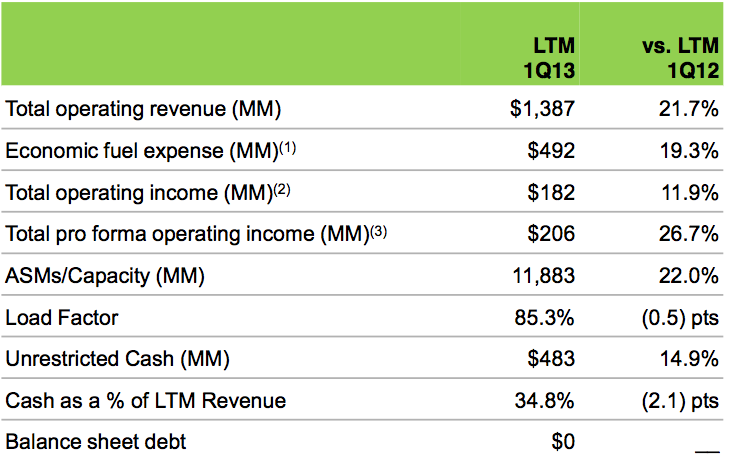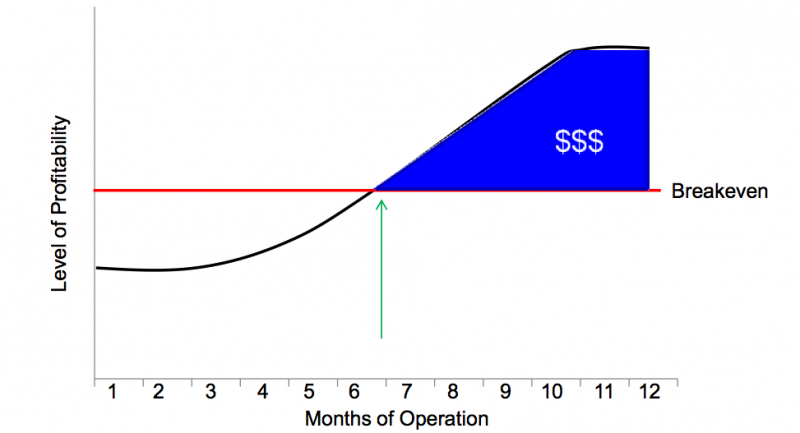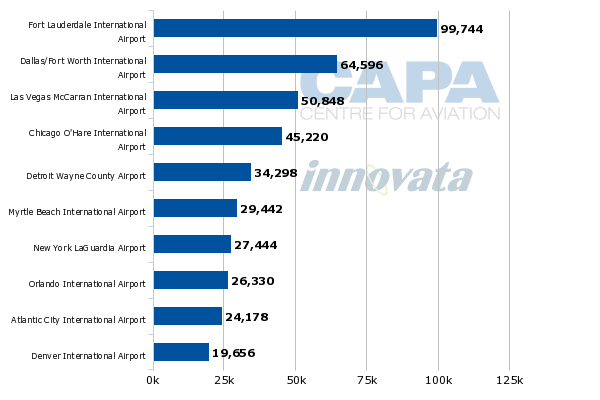Spirit Airlines makes minor network cuts as Dallas-Mexico expansion continues
Executives at Spirit Airlines often declare that if routes don't reach profitability within a given time the carrier will yank the service and redeploy assets on a bevy of other routes it has in the pipeline. Now the company is applying that logic to two relatively new routes that have launched within the last year. Service between Dallas/Fort Worth and Houston that began in Sep-2012 is ending in Sep-2013 while flights it launched from Philadelphia to Las Vegas in Apr-2013 are ending in Jan-2014.
Since it began a rapid domestic expansion in 2011 Spirit has quickly eliminated some routes that fail to prove out its business case of reaching break-even or profitability within six months. It ended service from Dallas/Fort Worth to Boston and between Chicago O'Hare and Los Angeles within roughly a year from launch.
At the same time Spirit has decided to shave markets from Houston and Las Vegas, it is stepping up its seasonal service from Dallas/Fort Worth (DFW) to Mexico, reflecting its strategy to use DFW as a springboard into transborder markets similar to its push from Fort Lauderdale to the Caribbean and Latin America that dominated the majority of its expansion during the last decade.
The carrier's ability to quickly redeploy assets is an attribute of its strategy to enter markets with just enough frequency to stimulate low-yielding traffic rather than steal passengers away from other carriers. The by-product of that approach is Spirit largely being left alone, which would mean that if a route underperforms it is likely a miscalculation by Spirit rather than an assault from another carrier.
See related reports:
- Spirit exploits the new low-fare market niche in the US to achieve consistent profitability
- Spirit assures opportunities abound to stimulate traffic in the US market
Spirit opts to cut the first route it inaugurated from Houston when flights to DFW cease
Both routes that Spirit is eliminating fit its market profile quite well - routes served by legacy carriers with a high-fare lock on the pairing. Dallas was the first market Spirit introduced from Houston in Sep-2012 and since that time the ultra-low-cost carrier has quickly added six markets from Bush Intercontinental - Chicago O'Hare, Denver, Detroit, Orlando, Los Angeles and Las Vegas.
Current schedules show that Spirit competes with American and United on its flights between Dallas and Houston. The route seems like a logical win for Spirit given that American and United have strong hubs in Dallas and Houston Intercontinental, which means they are likely charging higher fares. Spirit's 15% seat share on the pairing (based on schedules in Innovata for 30-Jun-2013 to 6-Jul-2013) is one of the highest shares it holds on routes from Houston, second behind Detroit where it holds an 18% share (Detroit is Spirit's fifth largest base in terms of seats deployed). In addition, Southwest operates approximately 11,477 weekly one-way seats between Houston Hobby and Dallas Love Field, so perhaps stimulating lower-yielding traffic the market was tough given the ample capacity between the two Dallas and two Houston airports.
Seat share percentage breakdown on Spirit's routes from Houston: 30-Jun-2013 to 6-Jul-2013
| Route | Carrier seat share |
|---|---|
| Chicago O'Hare | American 9%, Spirit, 5%, United 86% |
| Dallas/Forth Worth | American 55%, Spirit 15%, United 29% |
| Denver | Frontier 14%, Spirit 9%, United 77% |
| Detroit | Delta 47%, Spirit 18%, United 35% |
| Orlando | Spirit 14%, United 86% |
| Las Vegas | Spirit 11%, United 89% |
| Los Angeles | American 7%, United 89%, Spirit 5% |
Much like Dallas, overall Houston seems like a natural market for Spirit to build up given it is regularly featured at the top of the US Department of Transportation's list of highest fare airports. United's hubs in Houston, Washington Dulles and Newark always land near the top and 4Q2012 (the latest data available) was no different. Those hubs were ranked third, fourth and fifth among the five highest airports with fares of USD501, USD493 and USD484, respectively.
US Airports with the highest fares: 4Q2012
Spirit made the changes to its Houston-Dallas/Forth Worth service in global distribution systems in Jun-2013, roughly nine months after introducing service in the market. The carrier has previously calculated that it generally gives a market six months to mature. It will keep operating the route for about three more months until a schedule change, so the underperforming market will be a part of its network at least for the next few weeks.
Average time for Spirit's markets to reach break-even or profitability
Spirit's elimination of Las Vegas leaves just one regular route in Philadelphia
It is likely pure coincidence, but Southwest also operates on the second route Spirit plans to cut Las, Vegas-Philadelphia, which was just launched in Apr-2013. Presently, Southwest and Spirit each account for a roughly 15% seat share on the pairing while US Airways has a 69% share. Given the strong leisure base in Las Vegas, Spirit's bare bones product may have failed to gain traction given the fares offered by Southwest and US Airways were more reasonable than in other markets. During 4Q2012 Las Vegas was the fourth lowest-fare airport in the domestic US.
US Airports with the lowest fares: 4Q2012
Spirit's commitment to Las Vegas remains steadfast as passenger numbers climb
However, Spirit's presence is Las Vegas is solidified as it now has a crew and maintenance base at the airport. While Philadelphia-Las Vegas may have missed the mark, there is ample opportunity for Spirit to target the low-yielding, cost conscious travellers that flock to Las Vegas.
Spirit has been building up Las Vegas since 2010, and now the airport is its second largest base. Its expansion has resulted in Spirit now accounting for about 8% of the seats on offer from Las Vegas, and year-to-date in May-2013 Spirit's passenger numbers at the airport jumped 20% while overall passenger numbers at the airport notched down 0.3%.
Spirit Airlines top 10 hubs/bases/stations by seats: 1-Jul-2013 to 7-Jul-2013
Las Vegas McCarran International capacity by carrier (% of seats): 1-Jul-2013 to 7-Jul-2013
Presently, Spirit serves Baltimore-Washington, Chicago O'Hare, DFW, Detroit, Fort Lauderdale, Houston, Oakland, San Diego and Portland, Oregon from Las Vegas. Six of Spirit's top 10 bases are already served from Las Vegas. Orlando could be a possibility if it wants to compete with Southwest and Delta, which has not deterred Spirit in the past. As a result of its cost base, the fares it can charge in a heavy leisure market like Las Vegas-Orlando are still lower than tickets on Delta or Southwest.
Spirit expands seasonal DFW-Mexico service after wetting its feet with Toluca
As it makes refinements to its domestic network, Spirit Airlines is also building out international service at Dallas/Forth Worth with the resumption of seasonal service to Toluca, Mexico and the introduction of seasonal service from Dallas to Los Cabos and Cancun, Mexico. Both the new markets from DFW are familiar to Spirit as it operates service from San Diego to Los Cabos and from Detroit to Cancun.
Spirit began replicating its strategy of targeting cost-conscious visiting friends and relatives (VFR) and leisure travellers that it adopted at its largest base and headquarters of Fort Lauderdale and Dallas in 2012 with the launch of service to Mexico Toluca, roughly 69km away from Mexico City.
See related report: Spirit Airlines marks milestone with Dallas-Toluca flights
Part of Spirit's calculus in making such a huge push from DFW since returning to the airport in 2011 was its success in stimulating traffic in South Florida. American is the largest carrier at Miami (45km from Fort Lauderdale), so Spirit has ample experience in using its low fares to stimulate traffic in markets where legacies dominate and charge higher fares.
Spirit faces familiar competition on its flights from DFW to Cancun and Los Cabos from American. Schedules in Innovata show that Sun Country also operates service from Dallas to Cancun. Spirit's low frequency strategy of stimulating just enough traffic to turn a profit is playing out in both its new markets as it accounts for roughly 18% of the seats on offer from Dallas (with American holding the majority of 82%) to Los Cabos and 14% on service to Cancun. Sun Country has an 18% share of the seats deployed to Cancun while American has a 67% share.
Spirit's sound financial results allow for some route miscues
With Spirit's drastic build-up in the US domestic space during the last couple of years particularly from DFW and Las Vegas, there are some miscalculations that are bound to occur. Its abrupt decisions to exit markets somewhat shortly after launch reflect the carrier's often-stated mantra that it aggressively manages its assets to turn profits. So far the strategy seems to be sound - its profits grew nearly 31% during 1Q2013 while operating income grew by 33%. At the same time its USD6 cent unit costs excluding fuel and special items remains one of the lowest among US domestic carriers. For the moment it seems Spirit can afford a few missteps in expanding its strategy in the US domestic market and new near-international routes from its new US bases.
Spirit Airlines select financial results: 1Q2013 vs 1Q2012





